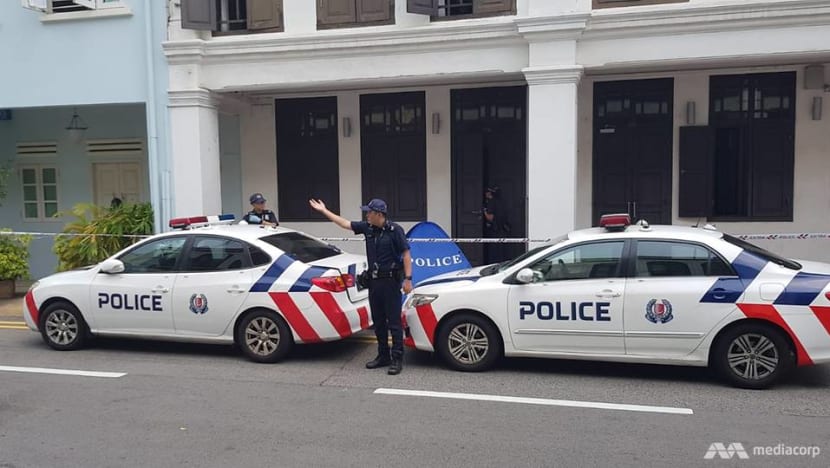Witnesses did not use ‘excessive force’ to restrain man who died after being caught taking upskirt photos: Coroner

A police tent was seen along Niven Road, Nov 1, 2019.
SINGAPORE: Witnesses who pinned down a man after he was caught taking upskirt photos at Little India MRT station did not behave in an “overly aggressive” manner or use "excessive force" to restrain him before he died, said a coroner.
Mr Andrew Ho Chee Meng, 46, died on Nov 1, 2019 on a pavement outside 56 Niven Road when he was chased and restrained by several men after he was spotted trying to take the illicit photos.
By the time the police arrived, Mr Ho was unresponsive and had vomited on himself. He was pronounced dead at the scene by a paramedic.
A forensic pathologist certified that the cause of death was hypothyroid cardiomyopathy, a "natural disease process".
"(The pathologist) opined that it was likely that the stress of running/chasing and/or the subsequent restraint had contributed to Mr Ho's death," said state coroner Kamala Ponnampalam in her findings that were released on Tuesday (Sep 22).
She added that Mr Ho's external injuries were "superficial and did not cause or contribute to the death".
But she added that the witnesses were "obviously unaware" of the medical risks when it comes to restraint methods or the "need to continually monitor as a means of mitigating that risk".
"The efforts of the members of public to apprehend and then to confine (Mr Ho) who was spotted doing an unlawful act, is commendable. But certain aspects of their actions merit comment," she said.
CAUGHT TAKING UPSKIRT PHOTOS
At about 12.40pm on Nov 1, 2019, a member of public Mr Ng Kim Tong noticed Mr Ho using his mobile phone on an escalator to take an upskirt photo of a woman who was standing in front of him.
Mr Ng shouted, prompting Mr Ho to run up the escalator. Another man, Mr Nardozi Thierry, heard the commotion and both men gave chase.
As Mr Ho ran out of the MRT station and across an open carpark, a third man, Mr Rudy Iskandar Khan, joined the pursuit.
They detained Mr Ho on a pavement outside 56 Niven Road after running for about 200m. Mr Ho struggled with Mr Ng holding onto his arms, and they fell to the ground.
“The three men then restrained (Mr Ho) in a prone position on the ground,” the coroner's findings said.
“They held onto his arms and Mr Nardozi placed his knee on the back of (Mr Ho’s) thighs.
“Mr Nardozi also took away (Mr Ho’s) handphone to prevent him from deleting any photographs."
READ: Suspected upskirter found dead after being detained by members of the public
Mr Ho’s alleged victim, who cannot be named due to a gag order, arrived at the scene and called the police.
A fourth member of the public who was driving by, Mr Leong Cheng Fong, saw the commotion and stopped to record a video of the incident. He stepped in to help, relieving Mr Ng.
“Mr Leong held (Mr Ho’s) left arm with one hand and placed his other hand on (Mr Ho’s) back to pin him down,” the coroner said. Mr Ho was still struggling and had started vomiting.
A short while later, a fifth man, Mr Racmat Hidayattullah Hasbullah, who was looking for his brother Mr Rudy, took over from his brother. Mr Racmat held onto Mr Ho’s right arm and shoulder and noticed the vomit next to the restrained man’s face.
The police arrived at the scene at about 12.50pm, about 15 minutes after they were alerted. When two police officers tapped Mr Ho on the shoulder, he did not respond.
"One of the men who had earlier restrained (Mr Ho) remarked that (Mr Ho) was putting on an act because the police were there," the coroner said.
One of the officers tried to turn him around and saw that Mr Ho’s eyes and mouth were open and there was vomit on his face and on the ground. He checked for a pulse but could not detect one and called for an ambulance.
Three more officers arrived at the scene and two performed CPR on Mr Ho, while other officers searched for a defibrillator.
A paramedic and her crew arrived and took over, and noticed that both Mr Ho's eyes were wide open and there was dried vomit on his face. Mr Ho was pronounced dead at the scene.
Video footage from various sources - the CCTV cameras at the MRT station and 56 Niven Road, the recording from Mr Leong's mobile phone and the police's body worn cameras - "fully captured" the sequence of events.
"Notably, the footage revealed that the witnesses had restrained (Mr Ho) by holding onto his arms and legs as well as by placing a hand on his back," said the coroner.
Footage from the officers' cameras showed Mr Ho was still being restrained when the authorities arrived and he was lying face down and motionless, with vomit near his face.
"NATURAL DISEASE PROCESS"
The forensic pathologist who performed the autopsy on Mr Ho said the death was due to a "natural disease process".
Mr Ho had a history of hyperthyroidism – or its severe form, Graves' disease, said Dr George Paul, senior consultant forensic pathologist in the Forensic Medicine Division at the Health Sciences Authority. He had radioactive iodine treatment to correct the thyroid gland's overactivity, but it led to him "becoming overcorrected".
The pathologist explained that hypothyroidism makes the heart slow to recover from the heart contraction in time for the next contraction and is sensitive to the falling levels of thyroid hormones. It can be treated with thyroxine, but Mr Ho had a "history of poor compliance" with his medication.
"Dr George further commented that is most likely that the running/chasing and/or the subsequent restraint had contributed to (Mr Ho’s) death, as he was already vulnerable to death from strain or struggle on account of his diseased heart due to the malfunctioning thyroid gland," the coroner's report said.
“There were no findings on examination of the body to suggest that (Mr Ho) would have died from his disease condition, if not from the stress of strain and struggle."
According to the coroner's report, Dr George also noted Mr Ho was seen at the Institute of Mental Health (IMH) and diagnosed with "paraphilia with borderline IQ, and voyeurism being a form of paraphilia".
“Upskirt video taking would also be considered as a paraphilia or perversion," said the coroner's findings.
During the forensic examination of Mr Ho’s devices, 47 upskirt photographs in his mobile phone were found, including two photos that were taken on Nov 1, 2019 at 12.22pm and 12.40pm.
Further examination of Mr Ho’s tablet and MicroSD card seized from his home revealed 498 upskirt photographs and 589 upskirt photographs respectively.
There were also 74 website histories relating to upskirt photographs found in another mobile phone taken from Mr Ho’s home.
PRUDENT TO PROMOTE REPORTING OF INCIDENTS TO POLICE: CORONER
While the coroner noted that the public’s efforts to apprehend and restrain Mr Ho were commendable, she said certain aspects of their actions "merited comment".
“When (Mr Ho) was lying prone on the ground, most of them had observed that (he) had vomited, but no attempt was made to reposition him or to actively check that he was well,” the coroner said.
“It was clear from the video footage that (Mr Ho) had stopped struggling and was lying motionless on the ground for some three minutes, but the witnesses either did not observe this or did not think that it was significant.
“(Mr Ho’s) unresponsive state was only detected after the police officers arrived at the scene and checked on him.”
The coroner said that while people are not "specifically discouraged" from helping those in need, it "may be prudent" to turn to the police because they are trained to restrain suspects.
“Public participation in crime prevention efforts is necessary and ought to be encouraged,” the coroner said.
“It may be prudent however, to promote reporting to police or seeking police assistance as the preferred and safer option.”














